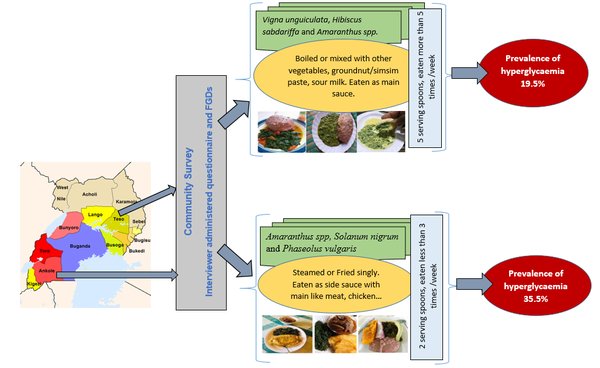-
Home
-
About JCTR
-
Gold Open Access
-
Issues
-
Editorial board
-
Author guidelines
-
Publication fees
-
Online first
-
Special issues
-
News
-
Publication ethics
-
Partners
-
Submit your manuscript
-
Submit your review report
-
Editorial Office
-

This work is licensed under a Creative Commons Attribution-NonCommercial 4.0 International License. ISSN print: 2382-6533 ISSN online: 2424-810X
Volume 9 Issue 6
Frequency of consumption of green leafy vegetables and prevalence of hyperglycaemia in Ankole and Teso sub-regions of Uganda
Caroline Asekenye, Paul Erasmus Alele, Patrick Engeu Ogwang, Eunice Apio Olet*
Asekenye et al. J Clin Transl Res 2023; 9(6):23-00096
Published online: November 12, 2023
Abstract
Background:
Type 2 diabetes-related hyperglyceamia is a global health problem, with
developing countries like Uganda currently experiencing substantial
rises in the metabolic disorder. Current hyperglycaemia therapies can
bring a patient to glycemic target; however, they are costly and have
other limitations. Vegetable extracts have health-protecting effects and
contain thousands of components with putative hypoglycaemic effects,
rendering them a cheaper alternative towards prevention and management
of hyperglycaemia.
Aim: The goal of this study was to determine the frequency
and patterns of consumption of green leafy vegetables, and their
relationship with the prevalence of hyperglyceamia in two sub-regions of
Uganda.
Methods: A cross sectional household survey was conducted in
Ankole and Teso sub-regions of Uganda. Using a questionnaire for both
face-to-face interviews and focus group discussions (FGDs), the
frequently eaten vegetables and their consumption were documented, and
fasting blood glucose (FBG) levels measured to determine the prevalence
of hyperglycaemia.
Results: The most frequently eaten vegetables in both
sub-regions were Amaranthus species. Brassica species, Curcubita maxima
L., Solanum nigrum s.l. and Phaseolus vulgaris L. were eaten mostly in
Ankole sub-region while Vigna unguiculata (L.) Walp. and Hibiscus
sabdariffa L. were eaten mostly in Teso sub-region. In Ankole
sub-region, the vegetables were steamed, while boiling and adding
peanut/simsim butter was preferred in Teso sub-region. Consumption of
leafy vegetables was higher in Teso sub-region than in Ankole
sub-region. The overall prevalence of hyperglycaemia was 29.15%; it was
higher in Ankole at 35.5% and lower in Teso at 19.5% (95% CI:
0.27-0.69).
Conclusion: The difference in prevalence of hyperglycaemia is
relatively high in these sub-regions. Consumption of different leafy
vegetable species and their various preparation methods likely
contributes to this prevalence; however, factors like phytochemical
constituents, genetics, and social-economic status could help explain
this difference further.
Relevance for patients: This study reveals that when
hyperglycaemic patients incorporate the consumption of appropriate
vegetables (in the recommended amount) and prepared using methods that
preserve and/or augment the nutrients and phyto-nutrients therein, in
their diet, they could control and prevent high blood glucose levels.

DOI: http://dx.doi.org/10.18053/jctres.09.202306.23-00096
Author affiliation
1. Department of Pharmacy, Faculty of Medicine, Mbarara University of Science and Technology, Mbarara City, Uganda
2. Department of Pharmacology and Therapeutics, Faculty of Medicine,
Mbarara University of Science and Technology, Mbarara City, Uganda
3. Department of Biology, Faculty of Science, Mbarara University of Science and Technology, Mbarara City, Uganda
*Corresponding author
Eunice Apio Olet
Mbarara University of Science and Technology, Department of Biology, P. O. Box 1410, Mbarara, Uganda.
Email address: eolet@must.ac.ug
Handling editor:
Michal Heger
Department of Pharmaceutics, Utrecht University, the Netherlands
Department of Chemistry, Utrecht University, Utrecht, the Netherlands
Department of Pathology, Erasmus Medical Center, the Netherlands
Department of Pharmaceutics, Jiaxing University Medical College, Zhejiang, China

